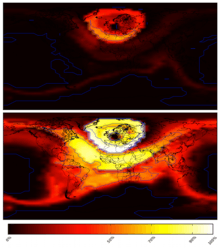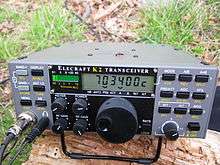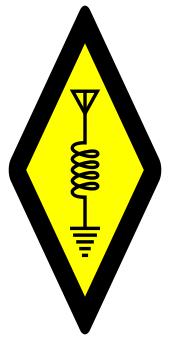QRP operation
In amateur radio, QRP operation refers to transmitting at reduced power while attempting to maximize one's effective range. QRP operation is a specialized pursuit within the hobby that was first popularized in the early 1920s. QRP operators generally limit their transmitted RF output power to 5 watts or less for CW operation and 10 watts or less for SSB operation.[1] Reliable two-way communication at such low power levels can be challenging due to changing radio propagation and the difficulty of receiving the relatively weak transmitted signals. QRP enthusiasts may employ optimized antenna systems, enhanced operating skills, and a variety of special modes, in order to maximize their ability to make and maintain radio contact. Since the late 1960s, commercial transceivers specially designed for QRP operation have evolved from vacuum tube to solid state technology. A number of organizations dedicated to QRP operation exist, and aficionados participate in various contests designed to test their skill in making long-distance contacts at low power levels.
Etymology
The term QRP derives from the standard Q code used in radio communications, where "QRP" and "QRP?" are used to request "Reduce power" and ask "Should I reduce power?" respectively. The opposite of QRP is QRO, or increased power operation.[2]
Philosophy
Most amateur transceivers are capable of transmitting approximately 100 watts,[3] but in some parts of the world, such as the U.S., amateurs can transmit up to 1,500 watts. QRP enthusiasts contend that this is not always necessary, and doing so wastes power, increases the likelihood of causing interference to nearby televisions, radios, and telephones and, for United States' amateurs, is incompatible with FCC Part 97 rule, which states that one must use "the minimum power necessary to carry out the desired communications".[4] QRP can also be used for emergency communications during disaster recovery.[5][6][7]
Practice

The practice of operating with low power was popularized as early as 1924, with a variety of reports, editorials and articles published in U.S. amateur radio magazines and journals that encouraged amateurs to lower power output, both for purposes of experimentation, and for improving operating conditions by reducing interference.[8]
There is not complete agreement on what constitutes QRP power. Most amateur organizations agree that for CW, AM, FM, and data modes, the transmitter output power should be 5 watts (or less).[9] The maximum output power for SSB (single sideband) is not always agreed upon. Some believe that the power should be no more than 10 watts peak envelope power (PEP), while others strongly hold that the power limit should be 5 watts. QRPers are known to use even less than five watts, sometimes operating with as little as 100 milliwatts or even less. Extremely low power—1 watt and below—is often referred to by hobbyists as QRPp.[4][5][6][10]
Communicating using QRP can be difficult since the QRPer must face the same challenges of radio propagation faced by amateurs using higher power levels, but with the inherent disadvantages associated with having a weaker signal on the receiving end, all other things being equal. QRP aficionados try to make up for this through more efficient antenna systems and enhanced operating skills.[10][7]
Weak signal modes
QRP enthusiasts may use special modes that employ technology and software designed to enhance reception of the relatively weak transmitted signals resulting from low power levels.[11]
- QRSS - very slow speed CW to compensate for the decreased signal-to-noise ratio involved in QRP operation.[11] QRSS derives from the standard Q code used in radio communications, where "QRS?" asks "Shall I send more slowly?".[2] QRSS enthusiasts may record a transmission for later analysis, sometimes decoding "by ear" while playing it back at much faster speeds, or decoding "by eye" on the waterfall display of a spectrum analyzer.[12][13]
- Coherent CW - the use of transmitters calibrated to a precise clock rate, allowing receivers to employ extremely narrowband filtering to increase readability.[11]
- WSJT - (Weak Signal - Joe Taylor) - to utilize several modes optimized for meteor scatter, troposcatter, and EME communications. WSJT was named to acknowledge physicist Joseph Hooton Taylor Jr.'s work in weak signal communication.[11]
- WSPR (Weak Signal - Propagation Reporter) - to monitor propagation paths for optimal communication conditions.[11]
Equipment

Many of the larger, more powerful commercial transceivers permit the operator to lower their output level to QRP levels. Commercial transceivers specially designed to operate at or near QRP power levels have been commercially available since the late 1960s. In 1969 the American manufacturer Ten-Tec produced the Powermite-1, one of Ten-Tec's first assembled transceivers, and featured modular construction. All stages of the transceiver were on individual circuit boards: the transmitter was capable of about one or two watts of RF, and the receiver was a direct-conversion unit, similar to that found in the Heathkit HW-7 and HW-8 lines, which introduced many amateurs to QRP'ing and led to the popularity of the mode.[14] Enthusiasts operate QRP radios on the HF bands in portable modes, usually carrying the radios in backpacks, with whip antennas. Some QRPers prefer to construct their equipment from kits, published plans,[15] or homebrew it from scratch. Many popular designs are based on the NE612 mixer IC, i.e. the K1, K2, ATS series and the Softrock SDR.[16]
Organizations
Amateur radio organizations dedicated to QRP include QRP Amateur Radio Club International (QRPARCI), American QRP Club, G-QRP Club based in the United Kingdom, and The Adventure Radio Society emphasizing portable QRP operation. Major QRP gatherings are held yearly at hamfests such as Dayton Hamvention, Pacificon, and Frederichshafen.[7]
Contests and awards
There are specific operating awards, contests, clubs, and conventions devoted to QRP enthusiasts. In the United States, the November Sweepstakes, June and September VHF QSO Parties, January VHF Sweepstakes, and the ARRL International DX Contest, as well as many major international contests have designated special QRP categories. For example, during the annual ARRL's Field Day contest, making a QSO (ham-to-ham contact) using "QRP battery power" is worth five times as many points as a contact made by conventional means. The QRP ARCI club sponsors 12 contests during the year specifically for QRP operators.[4][7]
Typical awards include the QRP ARCI club's "thousand-miles-per-watt" award, available to anyone presenting evidence of a qualifying contact. QRP ARCI also offers special awards for achieving the ARRL's Worked All States, Worked All Continents, and DX Century Club awards under QRP conditions. Other QRP clubs also offer similar versions of these awards, as well as general QRP operating achievement awards.[17]
Notes
- "Why QRP?". arrl.org. American Radio Relay League. Retrieved 10 December 2019.
- Marchant, William Henry (1914). Wireless telegraphy: a handbook for the use of operators and students. Whittaker. p. 220.
- The ARRL General Class License Manual. American Radio Relay League. 1998. pp. 3–. ISBN 9799072599963.
The maximum power output from most amateur transceivers is about 100 W
- Wells, Bradley (April 1984). "QRP: More Than a State of Mind". QST. Newington, CT: ARRL. p. 52. Retrieved 24 November 2019.
- Arland, Richard H. (2007). ARRL's Low Power Communication: The Art and Science of QRP. American Radio Relay League. ISBN 978-0-87259-104-2.
- George Dobbs (1 September 2012). QRP Basics. Radio Society of Great Britain. ISBN 978-1-905086-84-9.
- H. Ward Silver (25 February 2011). Ham Radio For Dummies. John Wiley & Sons. pp. 218–. ISBN 978-1-118-05419-2.
- Weiss, Adrian (1987). History of QRP in the U.S., 1924-1960. Vermillion, SD: Milliwatt Books. ISBN 9780961413910. OL 2411449M.
- Rutledge, David (1999). The Electronics of Radio. Cambridge University Press. p. 312. ISBN 9781107393660.
- Doug DeMaw (1991). W1FB's QRP Notebook. American Radio Relay League. ISBN 978-0-87259-365-7.
- "Weak Signal Modes". arrl.org. American Radio Relay League. Retrieved 24 November 2019.
- Mike Dennison; John Fielding (2007). Radio Communication Handbook. Radio Society of Great Britain. ISBN 978-1-905086-33-7.
- "QRSS Knights grabber compendium"
- Chaffin, Kenny A. (February 1990). "Why QRP?". QST. Newington, CT: ARRL. p. 43. Retrieved 24 November 2019.
- Brown, George (2001). "CW QRP transmitter for 80 meters". Radio and Electronics Cookbook. Newnes. ISBN 9780750652148.
- Weiss, Adrian. "The Five-Watt QRP Movement in the US, 1968-1981" (PDF). Miliwatt QRP Books. Retrieved 24 November 2019.
- "QRP -- What, Why and How". ARRL. Archived from the original on September 27, 2007. Retrieved April 4, 2007.

